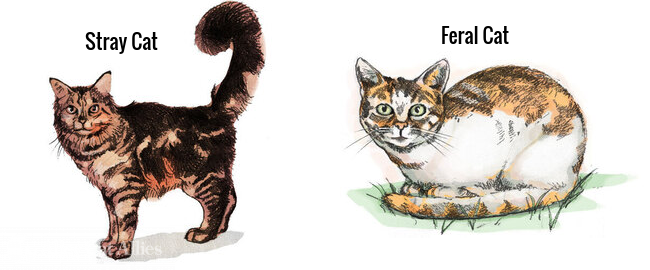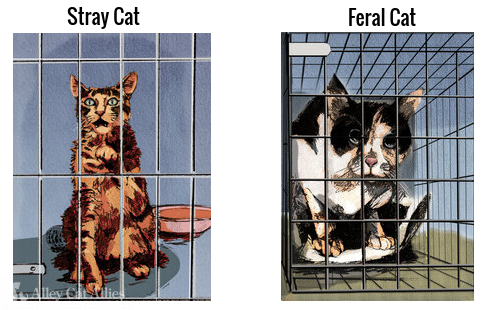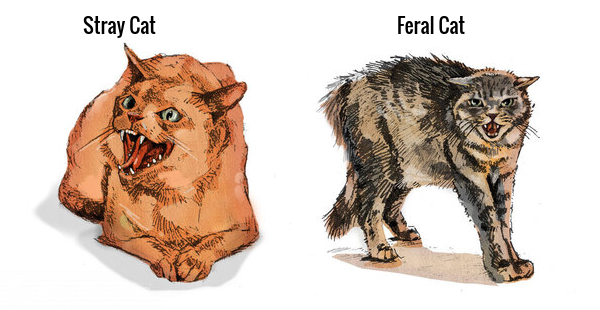You Make Kitty Stray Cat Again æ„âÂã¥â€˜â³
Quick Facts:
- "Community cat" is an umbrella term that refers to any member of the Felis catus species who is unowned and lives outdoors. Both feral and stray cats are community cats.
- Community cats have a wide range of behaviors and degrees of socialization. See our comprehensive Cat Socialization Continuum guide.
- Observing a true cat's beliefs, including their body language, tin can help you assess their level of socialization.
- Understanding a true cat'due south level of socialization can help you lot deed in their best interest.
- Trap-Neuter-Return (TNR) protects and improves the lives of all customs cats, regardless of their level of socialization.
Feral, stray, and pet cats are all members of the aforementioned species; they are all domestic cats. But stray cats and feral cats are also different from each other in a very of import way—in their relationship to and interactions with people.
Whether you are a shelter worker, veterinarian, or cat advocate—or you merely share your neighborhood with community cats—knowing how to tell the difference can assist inform how best to collaborate with a cat or what, if any, intervention would be in each true cat'south best interest.
- What is socialization?
- What is the departure between a devious cat and a feral cat?
- Why does it matter?
- How practise I tell the difference when the cats are outdoors?
- How do I tell feral and devious cats autonomously once I have trapped them?
- What do I do next?
What is socialization?
When we say a cat is "socialized" we hateful she is accustomed to and enjoys companionship with people. To socialize a cat means to acclimatize her to homo bear upon, human spaces, and homo sights, smells, and sounds. Information technology's a procedure that'due south influenced past many factors of a true cat'due south life and takes time and effort from compassionate people.
Kittens becomes socialized past interacting with people—beingness held, spoken to, and played with—from an early on age. If a kitten does not become accustomed to people holding her and petting her within this crucial window, she will grow up humble of humans and will non be suited to or happy living in homes.
What is the difference betwixt a devious cat and a feral cat?
Pet and stray cats are socialized to people.
Feral cats are not socialized to people. While they are socialized to their feline family members and bonded to each other, they do non take that same human relationship with people.
Community Cats
"Community cat" is an umbrella term that refers to any member of the Felis catus species who is unowned and lives outdoors. Both feral and stray cats are customs cats. Community cats have a wide range of behaviors and degrees of socialization, but they generally do not desire to live indoors and are unadoptable.
Stray:
- A stray cat is a cat who lived indoors and was socialized to people at some point in her life, but has left or lost her home, or was abandoned, and no longer has regular human contact.
- Over time, a stray cat tin can become feral as her contact with humans dwindles.
- A stray cat may be socialized enough to allow people to touch her, but she will become less socialized—or fifty-fifty feral—if she spends too much time without positive interaction with humans.
- Under the right circumstances, a stray true cat can also get a pet cat one time again. Stray cats that are re-introduced to an indoor dwelling after living outdoors may require a menses of time to re-acclimate; they may exist frightened and wary after spending time outside abroad from people.
Feral:
- A feral cat is an unsocialized outdoor true cat who has either never had any physical contact with humans, or human contact has macerated over plenty time that she is no longer accustomed to it. Almost feral cats are fearful or people and are not likely to ever go a lap cat or relish living indoors.
- Kittens built-in to feral cats can exist socialized at an early age and adopted into indoor homes.
- Aisle Cat Allies does not, in general, recommend trying to socialize a feral kitten over 4 months of age. Socializing is time consuming, especially for older kittens, and results are not guaranteed. Learn more well-nigh socializing kittens.
Why does it matter?
- Understanding the many degrees of socialization cats can showroom will assist you determine the best fashion to intendance for, help, and protect them. Run across our guide "The True cat Socialization Continuum: A Guide to Interactions Between Cats and Humans" for all the details.
- Devious cats can readjust to living with people and may be good candidates for adoption into indoor homes if people accept the time and means to foster and adopt.
- Stray and feral cats can be difficult to tell apart, peculiarly when they are trapped or frightened. Scared stray cats often need time to relax and evidence their level of socialization.
- Adult feral cats are not socialized to people, which means they cannot be adopted to indoor homes. As a effect, they are probable to be killed if picked up by animal command or brought to shelters, and then it is in their best involvement to continue living outdoors.
- Trap-Neuter-Return saves feral cats' lives, and benefits all community cats, regardless of their level of socialization. Cats who are office of TNR programs are humanely trapped, scanned for microchips, spayed or neutered, vaccinated, eartipped and microchipped (if they don't already have one). Stray cats who are thriving and don't have microchips indicating they are lost can be returned to their outdoor home or fostered and adopted.
How do I tell the difference when the cats are outdoors?
Since it is difficult to determine each cat'south socialization during a stressful event such as trapping, it'southward a good idea to find cats on their own outdoors using the guidelines below.
NOTE: There is a lot of variation on the Socialization Continuum. Cats may not fit solidly in either socialized-stray or unsocialized-feral categories. Learn more than variations possible using our Socialization Continuum guide.
Socialization to Humans
Devious: May approach people, houses, porches, or cars
Feral: Will not approach and will likely seek hiding places to avert people
Socialization to Other Cats
Stray: Will probable live alone, not part of a group
Feral: May belong to a colony
Body Language

Stray: Might walk and move like a house true cat, such equally walking with tail up—a sign of friendliness. Will probably look at you, blink, or make eye contact.
Feral: May crawl, crouch, stay low to the ground, and protect body with tail. Unlikely to brand eye contact.
Vocalization
Stray: May be vocal, meow, or "answer" your voice
Feral: Won't meow, beg or purr
Schedule
Stray: Volition exist visible primarily during the daytime
Feral: More likely to be nocturnal; occasionally out during the day
Concrete Appearance
Stray: Will probably be dirty or disheveled; will not accept an eartip.
Feral: Will probably have a clean, well-kept coat. A male with a large head and thick cervix, muscular body, and/or scars from fighting is more likely to be feral, since these are traits associated with intact males (and only two% of feral cats are neutered in the U.S.) He may also accept a spiky glaze from high testosterone levels and less time spent grooming; may likewise have "stud tail"—hair loss, greasiness, or bumps at the base of the tail due to hormones. Will likely have an eartip if neutered every bit part of a TNR program.
Pregnancy, Nursing, Kittens
Feral: A female person who is pregnant or lactating is more likely to be feral, since only 2% of feral cats are neutered in the U.S.
Recollect: A true cat'south level of socialization and behavior is not always blackness and white, particularly for community cats who recognize their caregiver.
They may show signs of familiarity, such every bit a tail up or hanging out on a caregiver'due south porch, but these behaviors are commonly express to the cat's interaction with the caregiver and just develop later edifice a human relationship over fourth dimension. Information technology's important to note that this behavior does not mean that the cat is a good candidate for living indoors.
How do I tell feral and stray cats autonomously once I have trapped them?
When in a frightening or stressful environment—such as a trap or a shelter—a friendly stray true cat may deed like a feral true cat, avoiding people and mayhap fifty-fifty showing aggression to avoid being touched. Who can blame them? The cat is in a new and unfamiliar place.
Here are some ways that will help distinguish a feral true cat from a scared stray cat when they are frightened, confined, or in a new identify.
Touch Barrier
Devious: It may be possible to touch the true cat somewhen or she may tolerate a pocket-size amount of touching with an object.
Feral: Cannot be touched, even by a caregiver.
Cage Behavior

Devious: May come to the front end of the cage. May somewhen rub confronting the muzzle in a friendly way.
Feral: Will likely stay in the back of the cage and retreat as far back as possible. If jolted or frightened, may shake, rattle, or climb the muzzle, and could become injured banging into the muzzle.
Level of Relaxation
Stray: May relax over fourth dimension.
Feral: Will remain tense and unsocial.
Responsiveness
Devious: May investigate toys or food placed most the cage. May respond to household sounds like cat food cans or bags being opened.
Feral: Volition likely ignore all people and toys, and perhaps fifty-fifty nutrient. Will not show any familiarity or involvement in household sounds.
Fear and Anxiety

Stray: May hiss or growl to show feet.
Feral: Volition be aggressive and lash out if threatened or cornered (signs of aggression include ears back and optics dilated).
What do I exercise adjacent?
Brand sure you have all the information needed to make a good evaluation. Once you accept evaluated a cat and feel like yous have a sense of the cat's level of socialization, the next step is to get the cat neutered. From in that location, use your evaluation to do what'south in the true cat's best interest, which may include:
- Returning customs cats to their outdoor home
- Maximizing a scared stray's chances of adoption
- Finding socialized cats a practiced adoptive home
- Socializing kittens for adoption
robertsleopragues.blogspot.com
Source: https://www.alleycat.org/resources/feral-and-stray-cats-an-important-difference/
0 Response to "You Make Kitty Stray Cat Again æ„âÂã¥â€˜â³"
Post a Comment